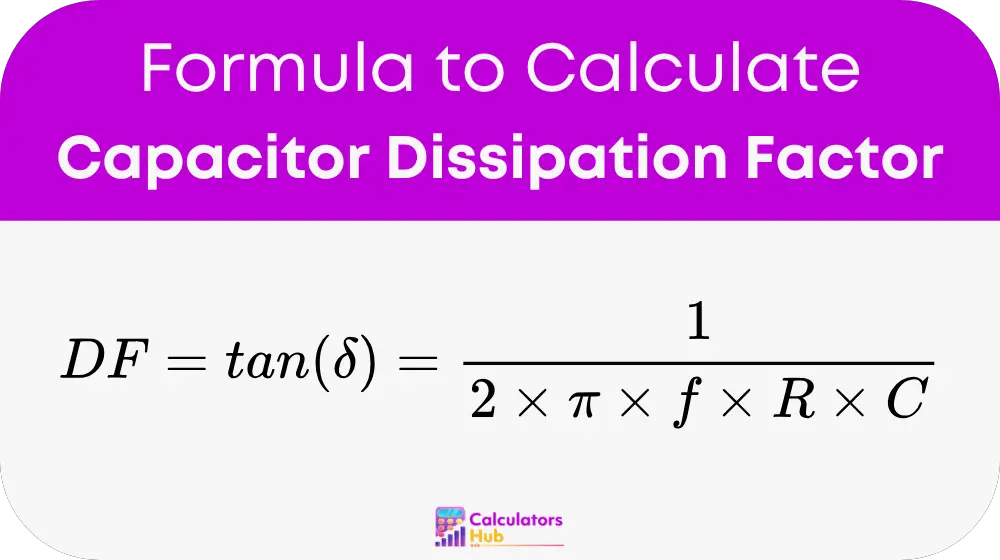A Capacitor Dissipation Factor Calculator helps you evaluate the energy losses in a capacitor during its operation in an AC circuit. The dissipation factor (DF) indicates how efficiently a capacitor can store and transfer electrical energy. It is a critical parameter in the design and selection of capacitors for AC applications, such as filtering, signal processing, and power conversion.
The dissipation factor is essentially the ratio of the energy lost to the energy stored in the capacitor per cycle of operation. A lower DF indicates a more efficient capacitor with lower energy loss, while a higher DF suggests greater energy dissipation, often due to internal resistance or imperfections within the capacitor's materials. The Capacitor Dissipation Factor Calculator makes it easy to calculate the DF based on key parameters like the equivalent series resistance (ESR), capacitance, and operating frequency.
Formula of Capacitor Dissipation Factor Calculator
The formula used to calculate the dissipation factor (DF) is:

Where:
- DF = Dissipation factor (unitless)
- δ = Loss angle in radians (which represents the phase difference between the current and voltage in the capacitor)
- f = Frequency of the AC signal in hertz (Hz)
- R = Equivalent series resistance (ESR) in ohms (Ω)
- C = Capacitance in farads (F)
- π = The mathematical constant pi, approximately 3.1416
Key Considerations
- Dissipation Factor and Loss Angle: The dissipation factor is directly related to the loss angle (δ), which represents the deviation from an ideal capacitor. In an ideal capacitor, the voltage and current would be perfectly out of phase, meaning there would be no energy lost. However, real capacitors have some internal resistance, leading to a small phase shift (loss angle) and energy loss.
- Equivalent Series Resistance (ESR): ESR represents the internal resistance of the capacitor, which causes energy dissipation in the form of heat. A lower ESR results in a lower dissipation factor, making the capacitor more efficient.
General Capacitor Dissipation Factor Values
The following table outlines typical dissipation factor values for different types of capacitors, giving you a general understanding of what to expect in different applications.
| Capacitor Type | Typical DF Range | Application Area |
|---|---|---|
| Ceramic Capacitors | 0.001 to 0.005 | High-frequency circuits, decoupling |
| Electrolytic Capacitors | 0.01 to 0.15 | Power supply filters, low-frequency AC |
| Film Capacitors | 0.0005 to 0.002 | Precision circuits, audio filtering |
| Tantalum Capacitors | 0.01 to 0.05 | Low-frequency applications, decoupling |
This table helps you quickly assess the efficiency of different types of capacitors in real-world applications. The Capacitor Dissipation Factor Calculator is an excellent tool for confirming whether a capacitor will meet the efficiency requirements for your specific circuit.
Example of Capacitor Dissipation Factor Calculator
Let’s consider an example to demonstrate how to calculate the dissipation factor.
Example:
- Frequency (f) = 1 kHz (1000 Hz)
- Equivalent series resistance (R) = 2 ohms
- Capacitance (C) = 10 µF (10 x 10^-6 farads)
- First, plug the values into the formula:DF = 1 / (2 * π * 1000 Hz * 2 Ω * 10 x 10^-6 F)
- Simplify the calculation:DF = 1 / (2 * 3.1416 * 1000 * 2 * 10 x 10^-6)DF ≈ 1 / 0.1257DF ≈ 7.95
So, the dissipation factor for this capacitor is approximately 7.95. This is relatively high, suggesting significant energy loss in the capacitor, which could be due to a high ESR or operating at a frequency where the capacitor is less efficient.
Most Common FAQs
A lower dissipation factor is generally better because it indicates less energy loss. For most applications, a DF below 0.01 is considered efficient, especially for high-frequency circuits. However, the acceptable range may vary depending on the type of capacitor and the application.
The dissipation factor depends on the frequency of the AC signal. At higher frequencies, some capacitors may exhibit higher energy losses due to the increased ESR. This is why high-frequency circuits often require capacitors with very low dissipation factors.
The equivalent series resistance (ESR) represents the internal resistance of the capacitor, and it directly affects the dissipation factor. A higher ESR increases the DF, indicating more energy lost as heat. Choosing a capacitor with a low ESR is crucial for minimizing energy losses.